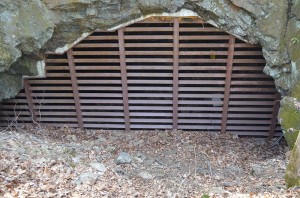Once said to be the last hope for saving our local and regional bat population, biologists from the Pennsylvania Game Commission discovered at winter’s end that the entire colony of bats living in the Durham bat  hibernaculum has been decimated. The property on which the hibernaculum resides was acquired in 2002 by Heritage Conservancy, an accredited not-for-profit land conservation organization located in Doylestown, PA, for the purposes of ensuring the protection of the bat population’s hibernating haven. Even with this protection from disturbance, the bats were unable to withstand the winter as a result of contracting the fatal infection that is devastating bat populations across the entire Northeast known as White Nose Syndrome (WNS).
hibernaculum has been decimated. The property on which the hibernaculum resides was acquired in 2002 by Heritage Conservancy, an accredited not-for-profit land conservation organization located in Doylestown, PA, for the purposes of ensuring the protection of the bat population’s hibernating haven. Even with this protection from disturbance, the bats were unable to withstand the winter as a result of contracting the fatal infection that is devastating bat populations across the entire Northeast known as White Nose Syndrome (WNS).
One of the last hibernacula (winter roosting sites) in the region to become infected with the disease, White Nose Syndrome was confirmed at the Durham bat cave in the fall of 2009. In 2008, it was estimated that the cave hosted 8,000-10,000 healthy hibernating bats; this winter, 23 bats were found living in the cave, half of which had signs of WNS.
First documented in Albany, NY in 2007, White Nose Syndrome is an infectious disease that affects all hibernating bat species and has a 96% total mortality rate. The infection has since spread to sixteen states along the East Coast and Midwest, as well as four provinces in Canada. WNS causes bats to lose their fat reserves, making it impossible for them to survive a winter in hibernation. They eventually starve to death. The fungus Geomyces destructans, believed to have been brought to the United States by hikers from Europe, has been identified as the causative agent. Infected bats have a white, cottony fungus present on their noses and wings. Since North American bats have no natural resistance to the fungus, and with no cure in sight, entire colonies have fallen victim to this disease at an alarming rate.
The ramifications of the decline in bat population could take a devastating toll on our ecosystem. One bat eats about 1,200 insects per hour in the summer; without bats to control pest levels, insects will fly rampant. Farmers will have no help from bats in repelling bugs, which could increase the use of insecticides. With insects such as mosquitoes that carry diseases, we could see an increase in human disease contractions.
Heritage Conservancy will continue to work with the Pennsylvania Game Commission in keeping with protocol for the preserved Durham bat hibernaculum. Greg Turner, Pennsylvania Game Commission biologist, said optimistically of the hibernaculum, “Since we know the Durham mine was a special site that attracted thousands of bats before the disease, along with the fact that it is a protected site, it will likely be avery important site for those few survivors out there, and into the future should we see some stabilization in numbers and actual recovery.”
“Heritage Conservancy will continue to protect this valued resource for the bat population. If they rebound, it will remain a haven to repopulate the colony,” stated Jeff Marshall, president of Heritage Conservancy.
If you would like more information on White Nose Syndrome, visit the PA Game Commission website at http://www.pgc.state.pa.us/. Or click HERE for a FAQ sheet. If you come across a bat that appears to be infected, please contact your state wildlife agency at WhiteNoseBats@fws.gov.